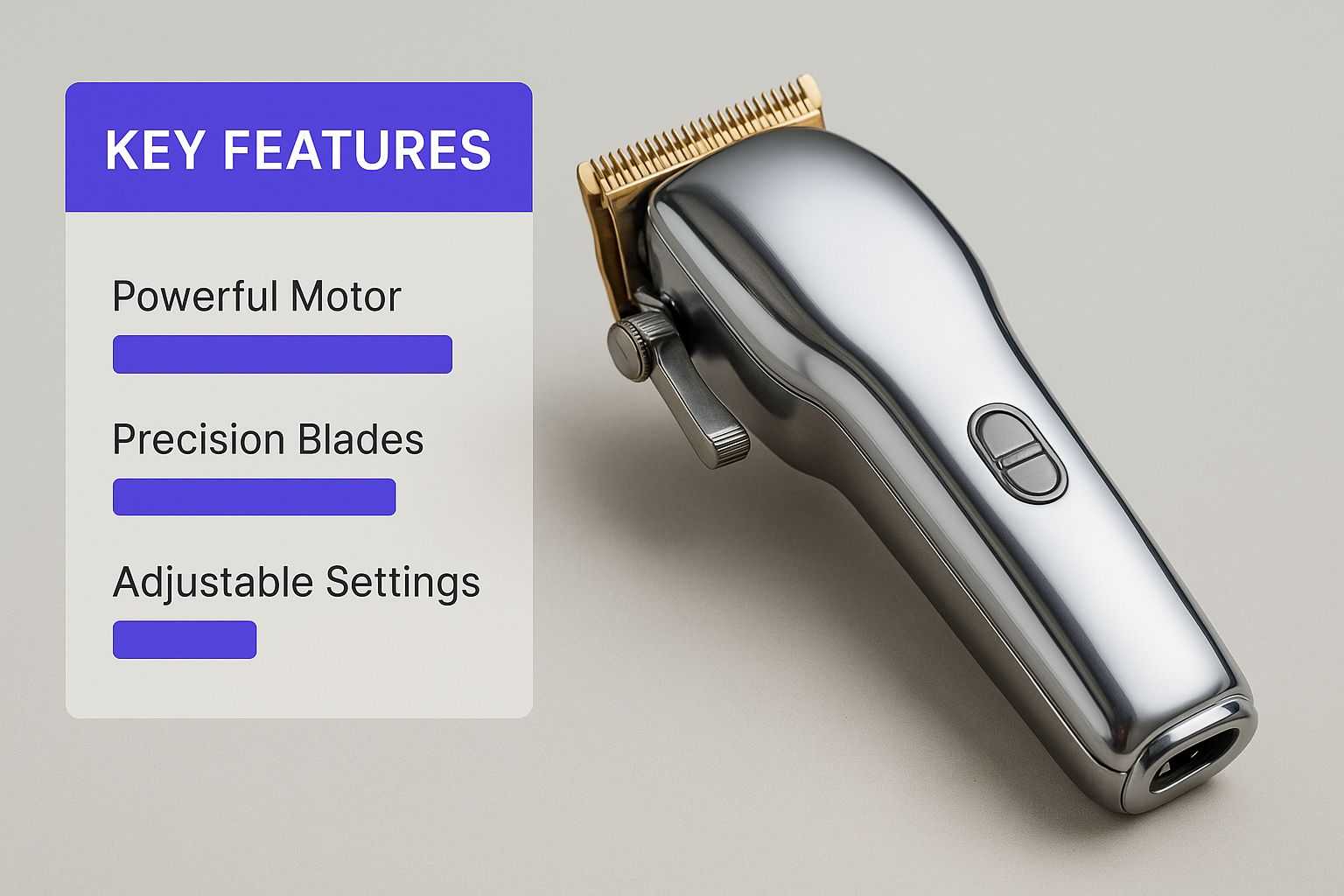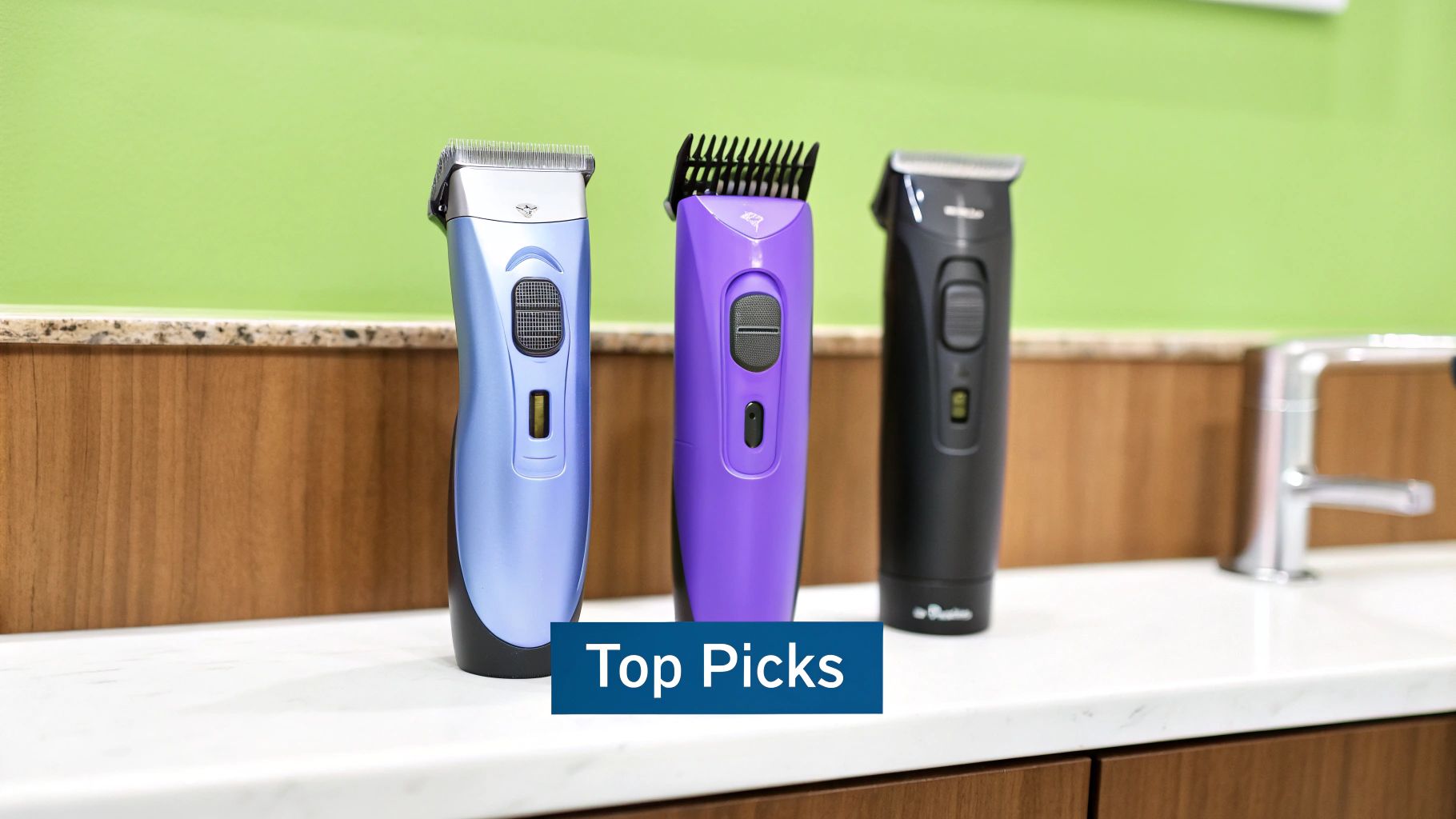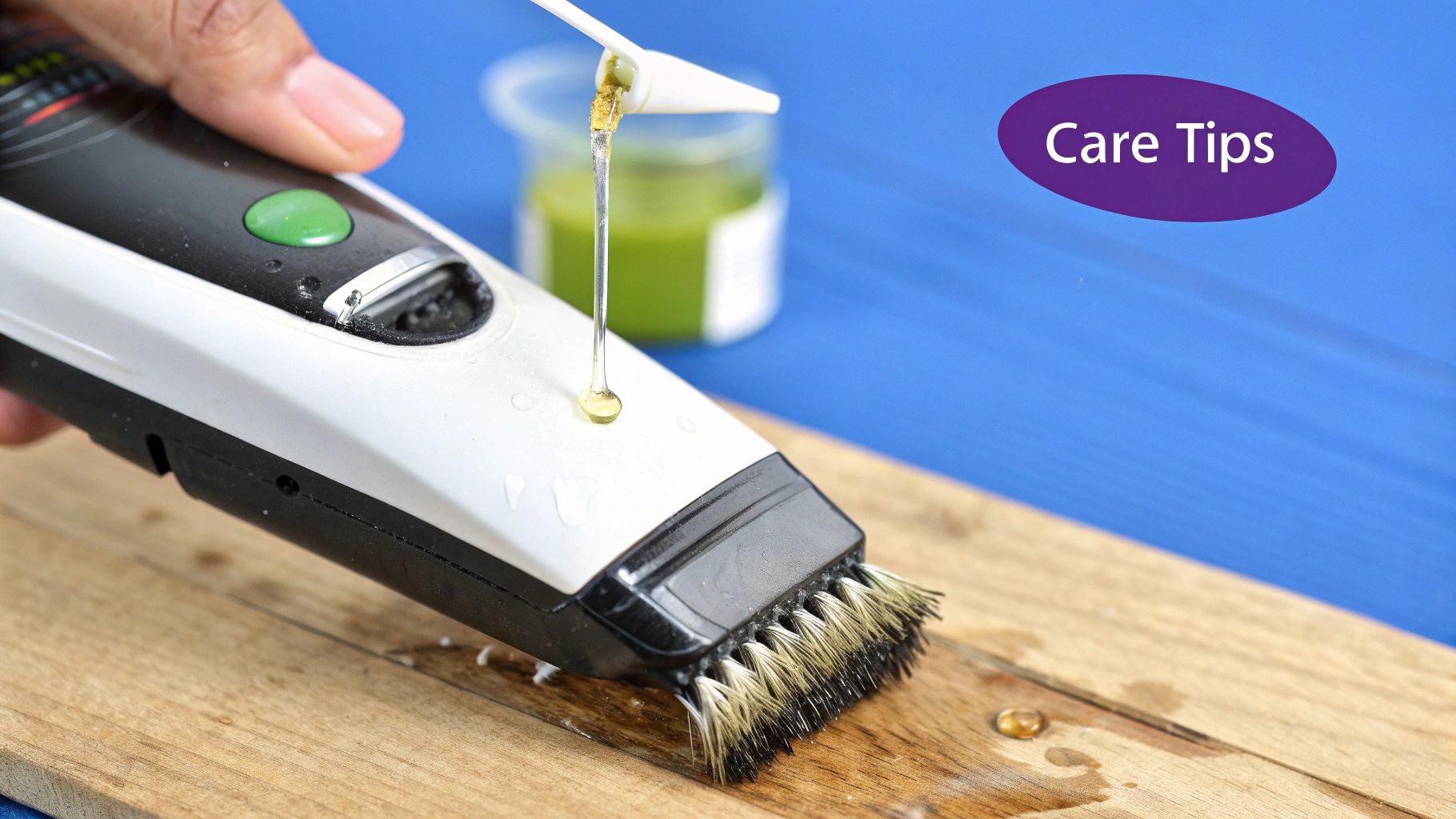
Finding the Best Hair Clippers to Maximize Your Barbershop's ROI
When you're searching for the best hair clippers, names like the Wahl Magic Clip, Andis Master, and BabylissPRO FX always come up, and for good reason. Each one is a workhorse. But the "best" for your shop depends entirely on your daily grind. Are you focused on heavy-duty bulk removal, intricate fade work, or do you need the total freedom of a cordless model to maximize client turnover?
This guide isn't another top-10 list. We're analyzing your clippers from a business owner's perspective—how the right tool directly impacts your shop's efficiency, client satisfaction, and bottom line.
Choosing Clippers: A Strategic Business Investment, Not an Expense
Let's be real: buying professional clippers is a strategic investment in your shop's productivity. The right tool means less barber fatigue after an 8-hour day, faster cuts leading to more appointments, and sharper results that build a loyal clientele who leave 5-star reviews. When you see it this way, you stop focusing on the price tag and start calculating the return on investment (ROI).
The electric clipper and trimmer market is booming, valued at USD 5.2 billion in 2023. This growth is driven by technology that meets professional demands: longer-lasting batteries, more powerful motors, and ergonomic designs that prevent career-threatening strain.
Framing Your Clipper as a Revenue-Generating Asset
Think about that premium $180 clipper you've been eyeing. Don't see it as an expense—see it as a money-making machine. A successful shop in Atlanta calculated that a high-performance clipper allowed each of their barbers to finish just one extra $40 haircut each week. That single clipper paid for itself in less than five weeks.
Over a year, that single tool could generate over $2,000 in additional revenue per barber. Suddenly, the initial cost seems minimal.
Actionable Takeaway: Shift your mindset. The question stops being, "How much does it cost?" and becomes, "What's the ROI for my business?" Analyze your service times and identify if new clippers could realistically add one more client per day or week.
If you're looking to upgrade all stations, you don't need a massive cash outlay. A solid guide to equipment financing for small business can show you how to fund the tools you need to grow without impacting your cash flow. Now, let’s get into the specifics—motors, blades, and designs—so you can choose equipment that elevates your craft and your profits.
Understanding The Engine Behind Every Cut
When choosing new professional clippers, the first thing to analyze is the motor. It’s like selecting an engine for a work truck—each is built for different performance needs. Getting this right is a business decision that directly impacts efficiency and service quality.
The three main types are magnetic, pivot, and rotary motors. Understanding their specific applications means every clipper you invest in becomes a workhorse, not just another tool collecting dust.
This infographic lays out the essential features you should be looking for in a professional-grade clipper.

As you can see, the motor and blades are the heart and soul of any clipper, defining its power, precision, and durability.
Matching Motor Power To Your Clientele
Analyze your appointment book. What hair types do you service most often? Are you doing high-volume, standard cuts on finer hair? Or are you a go-to for transformations on thick, coarse, or wet hair? The answer points you to the right motor.
Magnetic Motors: These are the sprinters, built for speed. They're fast, reliable, and ideal for everyday cuts on fine to medium hair. For a walk-in-focused shop, a magnetic motor clipper is your key to high turnover.
Pivot Motors: For clients with thick, heavy, or damp hair, you need torque, not just speed. Pivot motors run slower but pack more power. This prevents snagging on challenging hair, giving you a smooth, clean cut where a magnetic motor would struggle and require multiple passes.
Rotary Motors: The rotary motor is the versatile all-rounder. It delivers a balance of speed and power, handling any hair type you throw at it. You’ll often find these in top-tier cordless models, perfect for the master barber who needs one clipper to do it all with precision.
Let's break down how these motors stack up in a real-world shop environment.
Comparing Professional Clipper Motors
| Motor Type | Power & Speed | Best For | Pros | Cons |
|---|---|---|---|---|
| Magnetic | High speed, lower power | Fading, tapering, and general cutting on dry, finer hair | Very fast blade speed, reliable, fewer moving parts, affordable | Can be noisy, may struggle with very thick hair |
| Pivot | Lower speed, higher power | Bulk removal and cutting through thick, heavy, or wet hair | Powerful torque, quiet operation, smooth cutting | Slower blade speed, not ideal for fine-detail fading |
| Rotary | Balanced speed & power | All hair types (wet or dry), heavy-duty use, and detailing | Versatile, powerful, durable, often used in cordless models | Can be heavier, typically more expensive |
Ultimately, choosing the right motor means you can work more efficiently, deliver better results, and improve the client experience.
Actionable Takeaway: Don't use a single tool for every job. A barbershop in Chicago equipped each station with both a high-speed magnetic clipper for fading and a high-torque pivot clipper for bulk removal. They reported reducing cut times by an average of 5-7 minutes on difficult hair types, creating two extra booking slots per barber each day.
Understanding your tools is the foundation of a profitable barbershop. For a complete look at what you need in your toolkit, check out our comprehensive guide to essential barber tools and equipment.
Why Blade Quality Defines Your Craftsmanship and Profitability
If the motor is the heart of your clippers, the blades are the hands—it’s where skill meets hair. Blade material and sharpness directly control cut quality, maintenance time, and ultimately, your shop's profitability.
A cheap blade doesn't just cut poorly; it snags, pulls, and leaves choppy lines. This forces you to do more passes, irritating the client's skin and damaging your reputation for clean, precise work. A quality blade glides through hair, making your job easier and keeping clients comfortable and more likely to return.

From Steel to Ceramic: A Business Decision
Understanding blade materials isn't just gear talk; it's about making a smart financial choice. Each option offers a different trade-off between performance, longevity, and cost.
- High-Carbon Stainless Steel: This is the industry standard. It’s tough, holds an edge well, and is cost-effective. The downside: steel heats up during back-to-back cuts and requires diligent oiling to prevent rust.
- Ceramic: A game-changer for high-volume shops. Ceramic blades run up to 75% cooler than steel, a major benefit for client comfort and tool handling. They also hold their edge significantly longer, reducing sharpening frequency.
- Titanium: This is a premium, long-term investment. It's incredibly strong, corrosion-proof, and built to last for years. While the upfront cost is higher, the extended lifespan offers a superior long-term ROI.
Blade technology is constantly evolving alongside innovations like faster charging and smarter motors. Keeping up with trends in grooming tool technology helps you stay competitive.
Actionable Takeaway: Do the math. A shop owner in Miami invested an extra $20 per clipper for ceramic blades. He calculated that reducing sharpening frequency from quarterly to twice a year saved each barber over $100 annually in sharpening fees and lost time. For his 5-chair shop, that's a $500 yearly savings.
Ultimately, choosing the right blade isn't just about a sharper cut. It’s about creating a better client experience while protecting your time and money through superior durability.
The Real ROI: Corded vs. Cordless Clippers
When deciding between corded and cordless clippers, looking past the initial price is critical. This decision impacts daily workflow, service speed, and your bottom line. Think of it as choosing between a heavyweight champion (corded) and a nimble martial artist (cordless)—both are powerful, but they win in different ways.
Corded clippers are the undisputed workhorses. They plug in and deliver unrelenting power, perfect for marathon days with clients stacked back-to-back. You’ll never have a battery die mid-fade, ensuring raw, reliable performance.
Cordless clippers bring a new level of freedom and efficiency. The ability to move around the chair, untethered, is a game-changer for modern barbering. It reduces wrist strain, enables quicker movements, and supports a cleaner, more organized station. For shops specializing in intricate design work, this freedom is non-negotiable.
Looking Beyond the Initial Price Tag
Let's talk numbers. A high-quality corded clipper might cost $120. Its cordless equivalent could be $200. The corded model is cheaper upfront. But that's not the full financial picture.
The $200 cordless clipper will likely require a $40 replacement battery every two years. However, the business case for cordless is compelling.
Actionable Takeaway: A barbershop owner in Austin, TX, switched his entire team to cordless clippers. He tracked service times and found that the freedom of movement cut the average haircut time by 10% (from 30 minutes to 27 minutes). This small efficiency gain was enough for each barber to fit one extra client per day, increasing daily revenue by $35 per chair. The clippers paid for themselves in under two months.
This choice is about balancing initial investment with long-term efficiency gains. Sourcing your tools from a professional VIP barber supply can help you acquire the right equipment at a competitive price, ensuring you're making a sound business decision.
Protecting Your Barbers and Your Investment

The best clippers do more than cut hair—they protect your most valuable asset: your barbers. High-end tools are an investment in your team's health and your shop's longevity. That protection starts with ergonomics.
Weight, grip, and balance are crucial for preventing repetitive strain injuries that can shorten a barber's career. A lighter, well-balanced tool reduces wrist and arm fatigue, enabling your team to perform at their best through a fully booked day without pain.
The Five-Minute Daily Maintenance Habit for Maximum ROI
Beyond ergonomics, daily maintenance is the single best thing you can do to protect your investment. A consistent five-minute routine at the end of each day can dramatically extend a clipper's life, ensuring it remains a reliable asset.
With the growth of the professional grooming market pushing the industry towards USD 2.8 billion by 2032, quality equipment is in high demand. Taking care of your gear is more important than ever.
Actionable Takeaway: Implement a mandatory end-of-day maintenance protocol: clean, oil, disinfect. This simple habit can easily double the lifespan of a $150 clipper. For a single barber, this translates to over $750 in savings on replacement costs over a five-year period, directly protecting your shop's bottom line.
This small time commitment pays off in equipment reliability and cost savings. For more tips on building a toolset that lasts, see our complete guide to assembling a professional barber kit.
Of course, protecting physical tools is just one piece of the puzzle. Safeguarding your shop’s reputation is just as vital. Following an an online reputation management guide ensures positive client reviews match the quality of your work.
Answering Your Top Questions About Pro Clippers
Investing in new equipment for your shop is a significant business decision. You need straight answers to feel confident about your purchase. Let's tackle the most common questions from barbershop owners.
Which Clippers Are Best for New Versus Experienced Barbers?
For apprentices or new barbers, prioritize a reliable and forgiving tool. The Wahl Magic Clip is an excellent choice. Its consistent magnetic motor and lightweight design are ideal for mastering fundamental techniques without being overwhelming. It's a dependable tool that helps build confidence.
Seasoned pros demand specialized power and precision for advanced techniques. They often gravitate towards high-torque rotary clippers like the cordless Andis Master or the BabylissPRO FX. These clippers provide the raw power and blade speed needed for seamless fades, intricate designs, and efficiently cutting any hair type, maximizing their output on busy days.
How Much Should a Barbershop Budget for a New Clipper Setup?
A smart starting budget for a single, fully-equipped station is $250 to $300. This allows for a primary workhorse clipper (around $90-$180) and a high-performance detailer or trimmer (usually $70-$120).
Actionable Takeaway: Investing in professional-grade tools from day one is a critical business move. It minimizes replacement costs, reduces downtime from equipment failure, and produces the consistent, sharp results that build a loyal clientele and drive repeat business. See it as an upfront investment to prevent future losses.
Think of this initial budget as insurance against the hidden costs and frustrations that come with cheaper, unreliable equipment.
Are Expensive Clippers a Worthwhile Investment for a Business?
Absolutely. For a professional barbershop, a premium clipper in the $150+ range isn't an expense—it's an investment in efficiency and quality. These tools are built for commercial use with superior motors that handle a non-stop workday, better blades that hold their edge longer, and more reliable batteries for cordless models.
This investment delivers tangible business results:
- Increased Efficiency: More power means cleaner cuts in fewer passes, reducing service time per client.
- Reduced Costs: Pro-grade construction means fewer repairs and replacements, lowering long-term operational expenses.
- Enhanced Client Experience: A quieter, smoother-running clipper is more comfortable for the client and less fatiguing for the barber, contributing to a premium service atmosphere.
The initial sticker price is quickly offset by the long-term reliability and efficiency they bring to your workflow, which directly impacts your shop's revenue and profitability.
Ready to elevate your shop's online presence? Cuts.site creates a stunning, professional bio site for your barbershop that syncs automatically with your Square booking system. Showcase your services, barbers, and locations with zero technical setup. Learn more at Cuts.site




